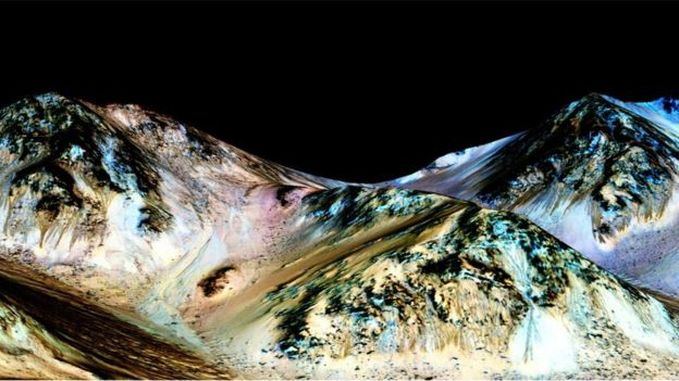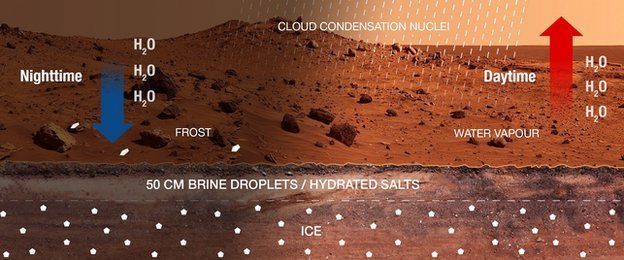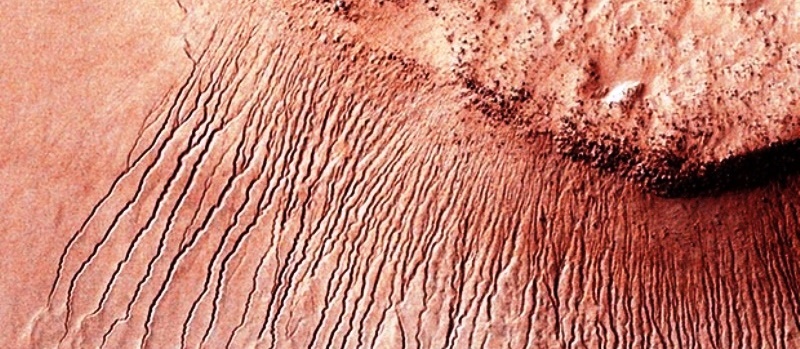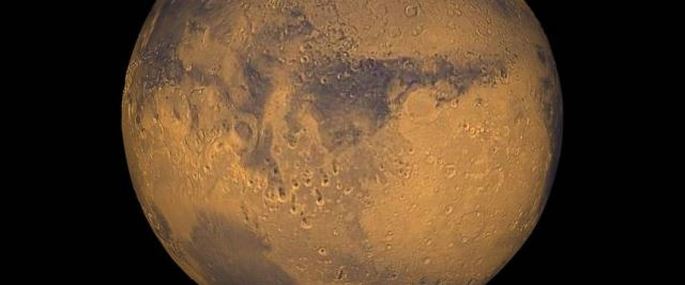NASA has announced exciting and long awaited news that liquid water has been discovered on the Mar’s rocky surface vanishing the perception of Mars as a Stoney desert like planet. The discovery emphasis the speculation that once live may have found on Mars or it may be found today!
Recently, a study about Mars has been published in the journal Nature Geoscience presented analysis of waterlogged molecules taken from the orbit.
“We now know Mars was once a planet very much like Earth with warm salty seas and fresh water lakes,” Jim Green, planetary science director at NASA, said at a news conference. “But something has happened to Mars, it lost its water.”
100 –meter long Dark long streaks flowing on Mars are thought to be formed by the contemporay follwing water NASA said. The stdudy emphasises that life like microbes may live inside the irony planet. But the scientist still does not have idea from where the salty water is coming on the planet.
"Something is hydrating these salts, and it appears to be these streaks that come and go with the seasons," Lujendra Ojha, a researcher from Georgia Tech who worked on the paper, stated this. "This means the water on Mars is briny, rather than pure. It makes sense because salts lower the freezing point of water.”
If humanity can goes to Mars, this is probably will be an excellent source of water stated Lujendra Ojha. He also added, "It's been three years of trial and error to get these readings."
“We now know Mars was once a planet very much like Earth with warm salty seas and fresh water lakes,” Jim Green, planetary science director at NASA, said at a news conference. “But something has happened to Mars, it lost its water.”
100 –meter long Dark long streaks flowing on Mars are thought to be formed by the contemporay follwing water NASA said. The stdudy emphasises that life like microbes may live inside the irony planet. But the scientist still does not have idea from where the salty water is coming on the planet.
"Something is hydrating these salts, and it appears to be these streaks that come and go with the seasons," Lujendra Ojha, a researcher from Georgia Tech who worked on the paper, stated this. "This means the water on Mars is briny, rather than pure. It makes sense because salts lower the freezing point of water.”
If humanity can goes to Mars, this is probably will be an excellent source of water stated Lujendra Ojha. He also added, "It's been three years of trial and error to get these readings."
Today’s discovery hints the idea that there were big rivers, lakes and vast oceans which flowed on Mars billions years ago! This discovery might be the root for the future human mission on Mars as it will reduce the load of the astronauts.
“I think all of the scientific discoveries we’re making on the surface of Mars…these observations are giving us a much better view that Mars has resources that are useful to future travels," John Grunsfeld, NASA associate administrator, said at the news conference. "I think all of the scientific discoveries we’re making on the surface of Mars, these observations are giving us a much better view that Mars has resources that are useful to future travels."
Now, reserchers are thinking whether the water of the mars follow occasionally accorss the surface of the mars.
For this research the scientist has looked at four locations where dark lines are found coming and going during summar. It was 15 years long observation. It is still unclear how the lines are made. It might be from the frozen water in the great deep of the of the hole. Another possibility is that the salt catually catches water from the atmosphere but again it is still undiscoverd whether there is plenty of air to facilitate water production. However, it is convincible that lines are being formed from the different sources in different part of the planet.
"By using the HiRise visible light camera and the CHRISM spectrometer aboard the same spacecraft, we could look at the same surface and acquire both pictures and ... spectra data to tell us about the chemical information at the same time," Mr Ojha said.
Dr Joe Michalski, a Mars researcher at the Natural History Museum in London called the statement a stimulating development, particularly for the potential of microbes existing on the planet today.
"We know from the study of extremophiles on Earth that life can not only survive, but thrive in conditions that are hyper-arid, very saline or otherwise 'extreme' in comparison to what is habitable to a human. In fact, on Earth, wherever we find water, we find life. That is why the discovery of water on Mars over the last 20 years is so exciting."
Still there is a "long way to go" before they can prove if the Red Planet could support life.
“I think all of the scientific discoveries we’re making on the surface of Mars…these observations are giving us a much better view that Mars has resources that are useful to future travels," John Grunsfeld, NASA associate administrator, said at the news conference. "I think all of the scientific discoveries we’re making on the surface of Mars, these observations are giving us a much better view that Mars has resources that are useful to future travels."
Now, reserchers are thinking whether the water of the mars follow occasionally accorss the surface of the mars.
For this research the scientist has looked at four locations where dark lines are found coming and going during summar. It was 15 years long observation. It is still unclear how the lines are made. It might be from the frozen water in the great deep of the of the hole. Another possibility is that the salt catually catches water from the atmosphere but again it is still undiscoverd whether there is plenty of air to facilitate water production. However, it is convincible that lines are being formed from the different sources in different part of the planet.
"By using the HiRise visible light camera and the CHRISM spectrometer aboard the same spacecraft, we could look at the same surface and acquire both pictures and ... spectra data to tell us about the chemical information at the same time," Mr Ojha said.
Dr Joe Michalski, a Mars researcher at the Natural History Museum in London called the statement a stimulating development, particularly for the potential of microbes existing on the planet today.
"We know from the study of extremophiles on Earth that life can not only survive, but thrive in conditions that are hyper-arid, very saline or otherwise 'extreme' in comparison to what is habitable to a human. In fact, on Earth, wherever we find water, we find life. That is why the discovery of water on Mars over the last 20 years is so exciting."
Still there is a "long way to go" before they can prove if the Red Planet could support life.

The study analyzed chemical signatures in streaks that form on some slopes on Mars during warmer times of the year, such the dark streaks in this image. 'These results strongly support the hypothesis that seasonal warm slopes are forming liquid water on contemporary Mars,' the researchers wrote. (NASA/JPL/University of Arizona)
Some fact about Mars & its Brine: (According to Geological report)
• Mars was once a warm wet world.
• Mars has only 1/99th the air pressure of Earth
• Salty water can remain liquid at lower temperatures and pressures than fresh water.
• The warmth of sunlight alone can liquefy salty water in the Martian soil
• When salty water evaporates it leaves a film of salts behind.
• These salts can also absorb water out of the Martian atmosphere,
• On Mars, water freezes into ice at 0 degrees Celsius, and boils at just 10 degrees Celsius because of relatively low air pressure.
• Water containing salts like sodium perchlorate can stay liquid down to minus 70 degrees Celsius, and will not start boiling until temperatures reach at 24 degrees Celsius.
The flows only appear when the surface of Mars rises above -23C. The water can run in such frigid conditions because the salts lower the freezing point of water, keeping it liquid far below 0C. For now, researchers are focused on learning where the water comes from. Porous rocks under the Martian surface might hold frozen water that melts in the summer months and seeps up to the surface.
• Mars was once a warm wet world.
• Mars has only 1/99th the air pressure of Earth
• Salty water can remain liquid at lower temperatures and pressures than fresh water.
• The warmth of sunlight alone can liquefy salty water in the Martian soil
• When salty water evaporates it leaves a film of salts behind.
• These salts can also absorb water out of the Martian atmosphere,
• On Mars, water freezes into ice at 0 degrees Celsius, and boils at just 10 degrees Celsius because of relatively low air pressure.
• Water containing salts like sodium perchlorate can stay liquid down to minus 70 degrees Celsius, and will not start boiling until temperatures reach at 24 degrees Celsius.
The flows only appear when the surface of Mars rises above -23C. The water can run in such frigid conditions because the salts lower the freezing point of water, keeping it liquid far below 0C. For now, researchers are focused on learning where the water comes from. Porous rocks under the Martian surface might hold frozen water that melts in the summer months and seeps up to the surface.
"We detected magnesium perchlorate, magnesium chlorate and sodium perchlorate," Mr Ojha said. "We're just starting to scratch the surface about these features, and there's a long way to go before we can safely say it is a habitable place or it has biological potential," Mr Ojha said.
"Mars is not the dry, arid planet we thought of in the past ... it once had extensive water resources," he said.
"Mars suffered a major climate change and lost its surface water. Today we're revolutionising our understanding of this planet."
NASA's associate administrator for science John Grunsfeld added: "It suggests that it would be possible for life to be on Mars today."
Dr Amanda Bauer from the Australian Astronomical Observatory added: "I can simply say that the potential presence of liquid water on the surface of Mars is incredibly exciting because water is essential for life as we know it to exist.
"More work is needed to understand how exactly these seasonal salty water streams are formed on Mars, but the new evidence for water flow is certainly an exciting step forward in understanding water activity on Mars." Mr Ojha said
In 2011, the high-resolution camera on NASA’s Mars Reconnaissance Orbiter captured little streams flowing down crater walls from late spring to early autumn. Even, Scientists in 2008 confirmed the existence of frozen water on Mars. . Pictures in the 1970s showed a surface crossed by dried-up rivers and plains once flooded beneath vast ancient lakes. Earlier this year, NASA unveiled evidence of an ocean that might have covered half of the planet’s northern hemisphere in the distant past.
"Mars is not the dry, arid planet we thought of in the past ... it once had extensive water resources," he said.
"Mars suffered a major climate change and lost its surface water. Today we're revolutionising our understanding of this planet."
NASA's associate administrator for science John Grunsfeld added: "It suggests that it would be possible for life to be on Mars today."
Dr Amanda Bauer from the Australian Astronomical Observatory added: "I can simply say that the potential presence of liquid water on the surface of Mars is incredibly exciting because water is essential for life as we know it to exist.
"More work is needed to understand how exactly these seasonal salty water streams are formed on Mars, but the new evidence for water flow is certainly an exciting step forward in understanding water activity on Mars." Mr Ojha said
In 2011, the high-resolution camera on NASA’s Mars Reconnaissance Orbiter captured little streams flowing down crater walls from late spring to early autumn. Even, Scientists in 2008 confirmed the existence of frozen water on Mars. . Pictures in the 1970s showed a surface crossed by dried-up rivers and plains once flooded beneath vast ancient lakes. Earlier this year, NASA unveiled evidence of an ocean that might have covered half of the planet’s northern hemisphere in the distant past.





